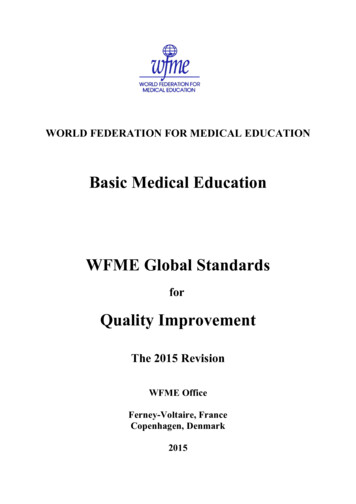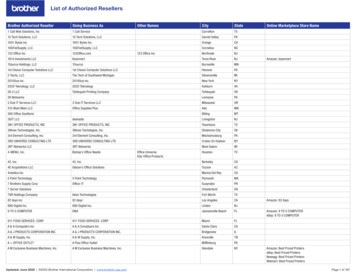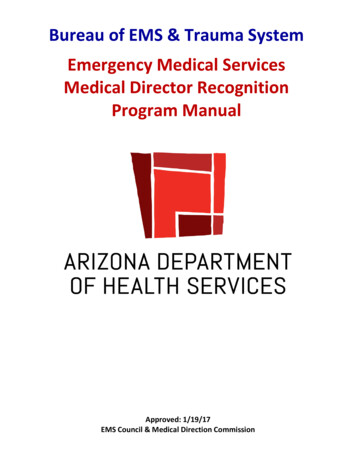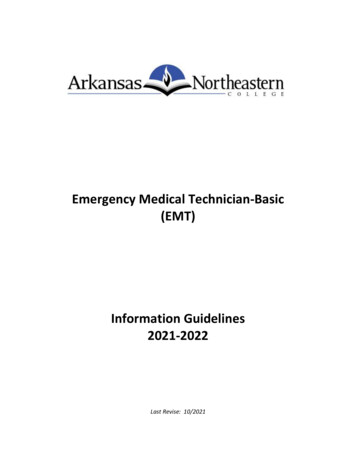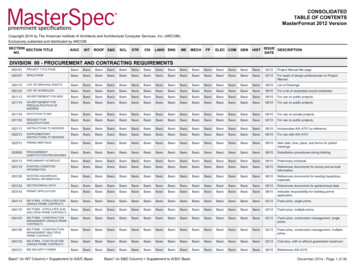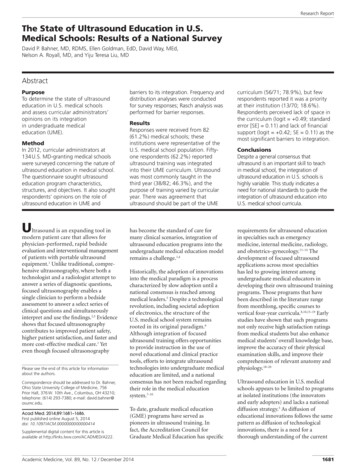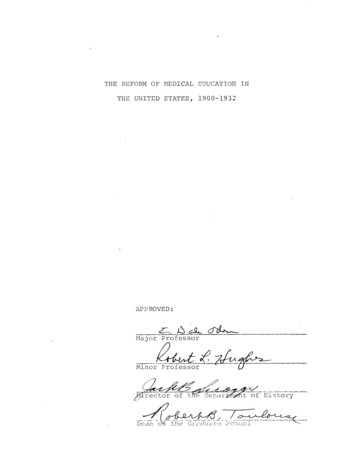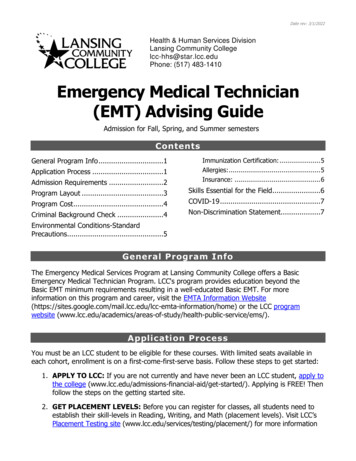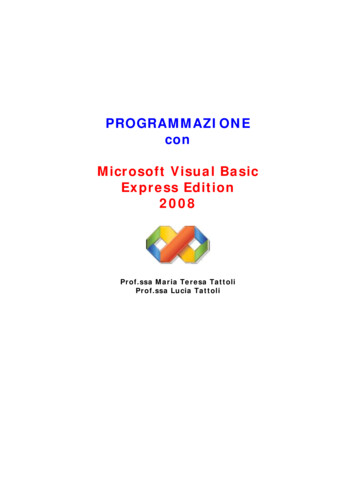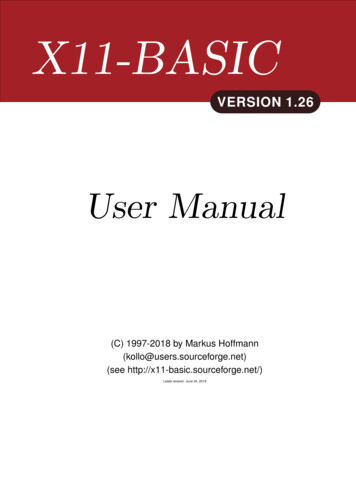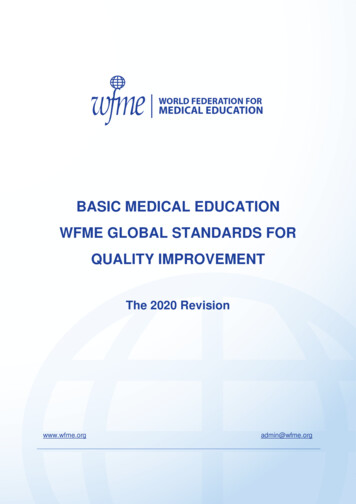
Transcription
BASIC MEDICAL EDUCATIONWFME GLOBAL STANDARDS FORQUALITY IMPROVEMENTThe 2020 Revisionwww.wfme.orgBasic Medical Education WFME Global Standards 2020admin@wfme.org WFME1
Acknowledgements . 3Foreword . 4Introduction . 5Reasons for the new standards . 5Global and local standards . 5Organisation of the revised standards . 6What are principles-based standards? . 6Using principles-based standards . 6Should agencies and schools replace their current standards? . 71. MISSION AND VALUES . 81.1Stating the mission . 82. CURRICULUM . 92.1Intended curriculum outcomes. 102.2Curriculum organisation and structure . 112.3Curriculum content . 122.4Educational methods and experiences . 143. ASSESSMENT . 153.1Assessment policy and system. 153.2Assessment in support of learning . 163.3Assessment in support of decision-making . 173.4Quality control . 184. STUDENTS . 194.1Selection and admission policy. 194.2Student counselling and support . 215. ACADEMIC STAFF. 225.1Academic staff establishment policy . 225.2Academic staff performance and conduct . 235.3Continuing professional development for academic staff . 236. EDUCATIONAL RESOURCES . 246.1Physical facilities for teaching and learning . 246.2Clinical training resources . 256.3Information resources. 267. QUALITY ASSURANCE . 277.1The quality assurance system . 278. GOVERNANCE AND ADMINISTRATION. 288.1Governance. 288.2Student and academic staff representation. 298.3Administration . 29Basic Medical Education WFME Global Standards 2020 WFME2
ACKNOWLEDGEMENTSWFME would like to thank the many people and organisations that commented on a draftversion of these standards. Their advice has made a difference to the content and clarity ofthe publication.We would also like to thank the core development team of Professor Janet Grant, ProfessorMichael Field and Dr John Norcini, for their work over 18 months in developing thestandards through countless drafts both before and after the consultation. Their work wasconstantly supported by Romana Kohnová.Basic Medical Education WFME Global Standards 2020 WFME3
FOREWORDThe World Federation for Medical Education (WFME) is pleased to publish this new, third,edition of the Standards for Basic Medical Education in the continuing programme of GlobalStandards for Quality Improvement of Medical Education. The first edition of these standardswas published in 2003, and the second edition in 2012 with a revision in 2015.Medical education does not stand still, and these revised standards have been written tokeep the WFME standards at the forefront of current understanding of the variety ofeducational practices and ideas and their relationship to local contexts.WFME has always emphasised that the standards are a guide to the development andevaluation of medical education in all settings. They are not prescriptive, and not a rulebook. They are intended to be used as a framework to be modified and customised for thelocal context. The new standards make this clear, and they ask users, whether they aremedical education managers, designers, teachers, learners, or regulators, to consider andthink through how every element of the work of the medical school should be developed bestto meet the local need and context.There are, world-wide, many sets of standards in use which were developed from the firstand second editions of the WFME standards for basic medical education. If those localstandards remain good and efficient, there is no need for them to be revised. WFMEstandards are for guidance. They are not a requirement or a directive. Therefore, there is norequirement that existing standards, if they work well, must be revised because of this thirdedition.The programme of standards for medical education is part of the evolving work of WFME.The first edition of the standards led to the question: now we have standards, can we usethem to evaluate the performance of medical schools? This led to the task force onaccreditation, a joint venture of WHO and WFME in 2004, leading in turn to the WFMEprogramme for the Recognition of Accreditation. With standards for education, and astrategy for accreditation, the need arose to know where all the medical schools are –eventually leading to the World Directory of Medical Schools. Now, with new standards forbasic medical education, we will develop new editions of the standards for postgraduateeducation and for continuing professional development. There will also be new standardsand guidelines for distant and distributed education in medicine.Basic Medical Education WFME Global Standards 2020 WFME4
INTRODUCTIONReasons for the new standardsWith increasing recognition of the importance of context in medical education, the WorldFederation for Medical Education (WFME) took the decision to review its standards toensure that they are applicable in all cultures and circumstances1.Added to this was our recognition that medical education is largely not an evidence-baseddiscipline. Instead, its practices tend to follow socially constructed values and ideas.Educational practice, therefore, varies between social and geographical contexts. What isright for one medical school, or one part of the globe, might not be right for another.WFME therefore decided to modify its standards, away from prescriptive, process-basedrequirements towards a principles-based approach2 which allows each agency or institutionto make its own version of the basic standards that is contextually appropriate. Those localstandards would then address the design, delivery, management, and quality assurance ofeducation and training, but in a manner tailored to context.The new standards invite institutions or organisations that wish to use them, to interpretthem for their own culture, resources, aspirations, and values, while still addressing thespecified areas of performance. We would expect a variety of locally relevant standards tobe derived within the broad framework that is set out in this publication.As in previous versions of these standards, we have set out a framework of areas fordefining and managing medical education, along with a statement of the importance of each.The principles-based standards in each area are presented along with guidance and keyquestions to consider when applying these to any given context. The key questions can alsobe used to inform enquiries into the quality of provision.Global and local standardsDespite setting out principles rather than prescriptions, global standards cannot always beperfect for every context.WFME acknowledges that in some countries, aspects of medical education, such as theadmission and student selection policies and procedures, are controlled by the governmentor the local accrediting agency or both. Some functions are therefore not locally decided butare nationally prescribed. Sometimes schools are part of a university and governed by theuniversity rather than being governed independently in their own right.In such cases, the global standards which deal with decision-making at the level of themedical school cannot apply. WFME standards that address these areas are therefore1Karle, H., Christensen, L., Gordon, D. and Nystrup, J. (2008) Neo-colonialism versus soundglobalisation policy in medical education. Medical Education, 42, 956–9582Black, J., Hopper, M. and Band, C. (2007) Making a success of principles-based regulation. Lawand Financial Markets Review, May, 191-206.Basic Medical Education WFME Global Standards 2020 WFME5
relevant only to those medical schools which have autonomy in these areas, and toaccrediting agencies and governments that might wish to review their own advice aboutthose policies and processes.If medical schools do not have control over issues set out in these standards, we would notexpect those standards to be applied.Organisation of the revised standardsThe standards are presented in eight areas:1.2.3.4.5.6.7.8.Mission and valuesCurriculumAssessmentStudentsAcademic staffEducational resourcesQuality assuranceGovernance and administrationThe standards address the elements of the educational programme which encompasses:The totality of all processes and activities that the medical school offers orenables, to facilitate student learning, wellbeing, and achievement.What are principles-based standards?Principles-based standards are not prescriptive and detailed, but are stated at a broad levelof generality2. They address the components of the educational programme, such as studentsupport, or a curriculum model, or an assessment system. But they do not say how supportshould be offered, nor what curriculum model should be adopted, nor what assessmentmethods should be used. They ask that the medical school states its mission and values, butthey do not say what that mission or those values should be. Those are contextual decisionsfor local agencies and schools. In this way, principles-based standards can meet thedifferent needs of regulatory agencies and medical schools around the world, whatever theirresources, contexts, purposes, and stages of development.Using principles-based standardsThis principles-based approach is designed to guide agencies and institutions in any andevery context. They might be used for new medical schools, for established medical schools,and for new or established regulatory systems.The revised standards offer flexibility for local decision-making about the specific qualitiesand characteristics that are required and are culturally and contextually appropriate. Thestandards are intended to be elegant, streamlined, and straightforward. They require thoughtBasic Medical Education WFME Global Standards 2020 WFME6
and discussion, but in that, they deter a shallow or instrumental compliance response and, itis hoped, might trigger a deep analysis of the educational process.These revised standards can be applied as they are, or can be used as the basis of a morespecific set of locally defined requirements that are developed for the context in question.Each standard offers associated guidance and key questions, to help local discussion anddefinition of the level of specificity that is fit for purpose. That purpose might range from localinstitutional development to national regulation.WFME recognises that some agencies and institutions might feel in need of more guidancebefore they can set their own standards. WFME is therefore developing various pathwayswhereby such guidance will be made available. Bodies might also consult with WFMERegional Associations or local qualified medical educationists. The standards might also bea topic for regional meetings and discussions.We hope that the revised standards will liberate productive analysis, thought, conversation,and decision-making, whether they are applied as presented here, or are supplemented withmore specific requirements.Should agencies and schools replace their current standards?WFME is clear that our standards have always been purely voluntary and for guidance only.The appearance of this new and revised version does not imply that existing national orlocal standards should be changed. If agencies are content with the standards they areusing, those standards can and should remain.In addition, we should clarify that there is no direct link between the previous or currentWFME standards and existing WFME recognition criteria for agencies accrediting medicalschools. The choice to map local standards on WFME global standards is purely voluntary.Agencies can define their standards in any way that is fit for their purpose.Please note: The standards stated refer to either ‘the school’ or ‘the medical school’. Bothterms mean the same thing: the institution or organisation that offers basic medicaleducation. In different places this might be called a ‘medical college’, or ‘medical faculty’ or avariety of other titles. For simplicity, the WFME standards use only ‘medical school’ or‘school’. These terms can be changed to suit the local choice.Basic Medical Education WFME Global Standards 2020 WFME7
1. MISSION AND VALUESImportance of this areaThis area concerns the purpose and values of the medical school. It provides the frame ofreference against which all other activities can be judged. The mission statement reflects themedical school’s distinct qualities.1.1 STATING THE MISSIONThe school has a public statement that sets out its values, priorities, and goals.Guidance:Consider the role, audiences, and uses of the mission statement.Briefly and concisely describe the school’s purpose, values, educational goals, researchfunctions, and relationships with the healthcare service and communities.Indicate the extent to which the statement has been developed in consultation withstakeholders.Describe how the mission statement guides the curriculum and quality assurance.Key questions:How is the mission statement specially tailored to the school?Which interested groups were involved in its development and why?How does mission statement address the role of the medical school in the community?How is it used for planning, quality assurance, and management in the school?How does it fit with regulatory standards of the local accrediting agency and with relevantgovernmental requirements, if any?How is it publicised?Basic Medical Education WFME Global Standards 2020 WFME8
2. CURRICULUMDefinitions: This section mentions four aspects of the educational work of the institution:Curriculum: ‘A curriculum might be defined as a managerial, ideological and planningdocument that should: tell the learner exactly what to expect including entry requirements, length andorganisation of the programme and its flexibilities, the assessment system andmethods of student support, advise the teacher what to do to deliver the content and support the learners in theirtask of personal and professional development, help the institution to set appropriate assessments of student learning and implementrelevant evaluations of the educational provision, tell society how the school is executing its responsibility to produce the nextgeneration of doctors appropriately.’3Course: All the planned teaching and learning from commencement to graduation, whichmay be divided into different parts (for example, disciplines, topics, modules, stages,semesters, phases), depending on the structure of the curriculum.Assessment: Measurement or judgement of student attainment.Evaluation: Review of the conduct of the course.Importance of this areaThis area addresses the central educational functions of the institution, which are defined bythe curriculum. There are many choices available in relation to the design of the curriculum.The structure, content, and educational methods chosen are related to the school’s mission,intended outcomes, and resources.3Grant, J. (2019) Principles of contextual curriculum design. Chapter 5, pp 71-88. In: Swanwick,T.,Forrest, K. and O’Brien, B.C. (eds) Understanding Medical Education. Evidence, Theory and Practice.Third edition. Wiley Blackwell, Oxford.Basic Medical Education WFME Global Standards 2020 WFME9
2.1 INTENDED CURRICULUM OUTCOMESThe school has defined the learning outcomes that students should have achievedby graduation, as well as the intended learning outcomes for each part of thecourse.Guidance:Outcomes can be set out in any manner that clearly describes what is intended in terms ofvalues, behaviours, skills, knowledge, and preparedness for being a doctor.Consider whether the defined outcomes align with the medical school mission.Review how the defined outcomes map on to relevant national regulatory standards orgovernment and employer requirements.Analyse whether the specified learning outcomes address the knowledge, skills, andbehaviours that each part of the course intends its students to attain. These curriculumoutcomes can be expressed in a variety of different ways that are amenable to judgement(assessment).Consider how the outcomes can be used as the basis for the design and delivery ofcontent, as well as the assessment of learning and evaluation of the course.Key questions:How were the intended outcomes for the course as a whole and for each part of thecourse designed and developed?Which stakeholders were involved in their development?How do they relate to the intended career roles of graduates in society?What makes the chosen outcomes appropriate to the social context of the school?Basic Medical Education WFME Global Standards 2020 WFME10
2.2 CURRICULUM ORGANISATION AND STRUCTUREThe school has documented the overall organisation of the curriculum, includingthe principles underlying the curriculum model employed and the relationshipsamong the component disciplines.Guidance:This standard refers to the way in which content (knowledge and skills), disciplines, andexperiences are organised within the curriculum. There are many options and variants,ranging from different models of integration to traditional pre-clinical and clinical phases,involving varying degrees of clinical experience and contextualisation. Choice ofcurriculum design is related to the mission, intended outcomes, resources, and context ofthe school.Key questions:What are the principles behind the school’s curriculum design?What is the relationship between the different disciplines of study which the curriculumencompasses?How was the model of curriculum organisation chosen? To what extent was the modelconstrained by local regulatory requirements?How does the curriculum design support the mission of the school?Basic Medical Education WFME Global Standards 2020 WFME11
2.3 CURRICULUM CONTENTa) The school can justify inclusion in the curriculum of the content needed toprepare students for their role as competent junior doctors and for theirsubsequent further training.b) Content in at least three principal domains is described: basic biomedicalsciences, clinical sciences and skills, and relevant behavioural and socialsciences.Guidance:Curriculum content in all domains should be sufficient to enable the student to achieve theintended outcomes of the curriculum, and to progress safely to the next stage of trainingor practice after graduation.Curriculum content may vary according to school, country, and context, even where anational curriculum is specified. Content from at least three principal domains would beexpected to be included:Basic biomedical sciences which are the disciplines fundamental to theunderstanding and application of clinical science.Clinical sciences and skills which include the knowledge and related professionalskills required for the student to assume appropriate responsibility for patient careafter graduation.Behavioural and social sciences which are relevant to the local context and culture,and include principles of professional practice including ethics.Content of other types may also be included:Health systems science which includes population health and local healthcaredelivery systems.Humanities and arts which might include literature, drama, philosophy, history, art,and spiritual disciplines.Basic Medical Education WFME Global Standards 2020 WFME12
Key questions:Who is responsible for determining the content of the curriculum?How is curriculum content determined?What elements of basic biomedical sciences are included in the curriculum? How are thechoices made and time allocated for these elements?What elements of clinical sciences and skills are included in the curriculum? In which clinical disciplines are all students required to gain practical experience? How are students taught to make clinical judgements in line with the bestavailable evidence? How are the choices made and time allocated for these elements? What is the basis for the school’s allocation of student time to different clinicalpractice settings?What elements of behavioural and social sciences are included in the curriculum? Howare the choices made and time allocated for these elements?What elements (if any) of health systems science are included in the curriculum? How arethe choices made and time allocated for these elements?What elements (if any) of humanities and arts are included in the curriculum? How are thechoices made and time allocated for these elements?How do students gain familiarity with fields receiving little or no coverage?How does the school modify curriculum content related to advances in knowledge?How are principles of scientific method and medical research addressed in thecurriculum?Which fields (if any) are elective? How are elective fields decided?How is student learning assured in disciplines in which they do not get specificexperience?Basic Medical Education WFME Global Standards 2020 WFME13
2.4 EDUCATIONAL METHODS AND EXPERIENCESThe school employs a range of educational methods and experiences to ensure thatstudents achieve the intended outcomes of the curriculum.Guidance:Educational methods and experiences include techniques for teaching and learningdesigned to deliver the stated learning outcomes, and to support students in their ownlearning. Those experiences might be formal or informal, group-based or individual, andmay be located inside the medical school, in the community, or in secondary or tertiarycare institutions. Choice of educational experiences will be determined by the curriculumand local cultural issues in education, and by available human and material resources.Skilfully designed, used and supported virtual learning methods (digital, distance,distributed, or e-learning) may be considered, presented, and defended as an alternativeor complementary educational approach under appropriate circumstances, includingsocietal emergencies.Key questions:What principles inform the selection of educational methods and experiences employed inthe school’s curriculum? How were these principles derived?According to what principles are the chosen educational methods and experiencesdistributed throughout the curriculum?In what ways are the educational methods and experiences provided for studentsappropriate to the local context, resources, and culture?Basic Medical Education WFME Global Standards 2020 WFME14
3. ASSESSMENTImportance of this areaAssessment assures, drives, guides, creates, and optimises learning while providingfeedback. In the context of a medical school, a system of assessment must exist, whichincorporates multiple assessments that achieve the purposes of the school and itsstakeholders.3.1 ASSESSMENT POLICY AND SYSTEMa) The school has a policy that describes its assessment practices.b) It has a centralised system for ensuring that the policy is realised throughmultiple, coordinated assessments that are aligned with its curriculumoutcomes.c) The policy is shared with all stakeholders.Guidance:An assessment policy with a centralised system that guides and supports itsimplementation will entail the use of multiple summative and formative methods that leadto acquisition of the knowledge, clinical skills, and behaviours needed to be a doctor. Thepolicy and the system should be responsive to the mission of the school, its specifiededucational outcomes, the resources available, and the context.Key questions:Which assessments does the school use for each of the specified educational outcomes?How are decisions made about the number of assessments and their timing?How are assessments integrated and coordinated across the range of educationaloutcomes and the curriculum?Basic Medical Education WFME Global Standards 2020 WFME15
3.2 ASSESSMENT IN SUPPORT OF LEARNINGa) The school has in place a system of assessment that regularly offers studentsactionable feedback that identifies their strengths and weaknesses, and helpsthem to consolidate their learning.b) These formative assessments are tied to educational interventions that ensurethat all students have the opportunity to achieve their potential.Guidance:Feedback is one of the biggest drivers of educational achievement4. Students need to beassessed early and regularly in courses and clinical placements for purposes of providingfeedback that guides their learning. This includes early identification of underperformingstudents and the offer of remediation.Key questions:How are students assessed to support their learning?How are students assessed to determine those who need additional help?What systems of support are offered to those students with identified needs?4Hattie, J., and Timperley, H. (2007) The power of feedback. Review of Educational Research, 77, 1,81-112.Basic Medical Education WFME Global Standards 2020 WFME16
3.3 ASSESSMENT IN SUPPORT OF DECISION-MAKINGa) The school has in place a system of assessment that informs decisions onprogression and graduation.b) These summative assessments are appropriate to measuring courseoutcomes.c) Assessments are well-designed, producing reliable and valid scores.Guidance:Assessment for decision-making is essential to institutional accountability. It is also criticalto the protection of patients. These assessments must be fair to students and, as a group,they must attest to all aspects of competence. To accomplish these ends, they must meetstandards of quality.Key questions:How are blueprints (plans for content) developed for examinations?How are standards (pass marks) set on summative assessments?What appeals mechanisms regarding assessment results are in place for students?What information is provided to students and other stakeholders, concerning the content,style, and quality of assessments?How are assessments used to guide and determine student progression betweensuccessive stages of the course?Basic Medical Education WFME Global Standards 2020 WFME17
3.4 QUALITY CONTROLa) The school has mechanisms in place to assure the quality of its assessments.b) Assessment data are used to improve the performance of academic staff,courses, and the institution.Guidance:It is important for the school to review its individual assessments regularly, as well as thewhole assessment system. It is also important to use data from the assessments, as wellas feedback from stakeholders, for continuous quality improvement of the assessments,the assessment system, the course, and the institution.Key questions:Who is responsible for planning and implementing a quality assurance system forassessment?What quality assurance steps are planned and implemented?How are comments and experiences about the assessments gathered from students,teachers, and other stakeholders?How are individual assessments analysed to ensure their quality?How are data from assessments used to evaluate teaching and the curriculum in practice?How are the assessment system and individual assessments regularly reviewed andrevised?Basic Medical Education WFME Global Standards 2020 WFME18
4. STUDENTSImportance of this areaAppropriate admissio
strategy for accreditation, the need arose to know where all the medical schools are - eventually leading to the World Directory of Medical Schools. Now, with new standards for basic medical education, we will develop new editions of the standards for postgraduate education and for continuing professional development.
